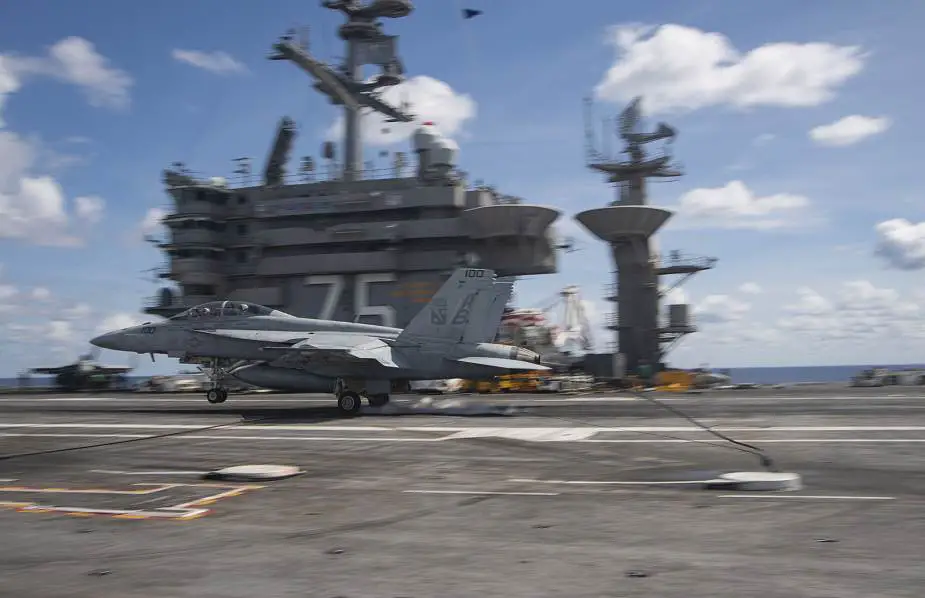Breaking news
US Navy USS Harry S. Truman CVN 75 aircraft carrier completes sea trials and qualifications.
According to information published by the U.S. Navy, the Nimitz-class aircraft carrier USS Harry S. Truman (CVN 75) returned to Norfolk on May 30, 2021, upon completion of 18-days of sea trials and carrier qualifications.
Follow Navy Recognition on Google News at this link
 An F/A-18F Super Hornet attached to the “Red Rippers” of Strike Fighter Squadron (VFA) 11 lands on the flight deck of the Nimitz-class aircraft carrier USS Harry S. Truman (CVN 75) during carrier qualifications after completing an extended incremental availability. (Picture source U.S. Navy)
An F/A-18F Super Hornet attached to the “Red Rippers” of Strike Fighter Squadron (VFA) 11 lands on the flight deck of the Nimitz-class aircraft carrier USS Harry S. Truman (CVN 75) during carrier qualifications after completing an extended incremental availability. (Picture source U.S. Navy)
Sea Trials is a comprehensive assessment to ensure that the ship’s systems are in working order after a maintenance availability period. Truman completed a large number of successful evolutions during sea trials, including small boat recoveries, aqueous film-forming foam sprinkler system testing, high speed turns, catapult testing, and a replenishment-at-sea alongside the fleet replenishment oiler USNS Joshua Humphreys (T-AO 188).
Since Truman’s Extended Carrier Incremental Availability maintenance period at Norfolk Naval Shipyard, Truman’s crew has also successfully passed rigorous testing on their abilities to perform in damage control, deck seamanship, and flight deck operations, simulating real scenarios that can occur at sea.
Truman’s flight deck crew conducted 1,040 arrested landings, about 200 more than normally completed during sea trials. Truman also achieved flight deck certification. Following a 10-month Extended Carrier Incremental Availability at Norfolk Naval Shipyard, Truman is in the basic phase of the Optimized Fleet Response Plan.
The USS Harry S. Truman (CVN-75) is the eighth Nimitz-class aircraft carrier in service with the United States Navy. She was commissioned in July 1998.
The Nimitz is a class of ten nuclear-powered aircraft carriers in service with the United States Navy. Instead of the gas turbines or diesel-electric systems used for propulsion on many modern warships, she uses two A4W pressurized water nuclear reactors which drive four propeller shafts and can produce a maximum speed of over 30 knots (56 km/h) and a maximum power of around 260,000 shaft horsepower (190 MW).
The Nimitz-class carrier has a length of 333 m overall, 317 m at the waterline, and a beam of 41 m. They have a full-load displacement of 101,196 long tons (102,820 t). The ship's complement is 558 officers and 5,454 enlisted (including airwing).
The Nimitz-class carrier can accommodate a maximum of 130 F/A-18 Hornets or 85–90 aircraft of different types, but current numbers are typically 64 aircraft. A typical carrier air wing can include 24–36 F/A-18E or F Super Hornets as strike fighters; two squadrons of 10–12 F/A-18C Hornets, with one of these often provided by the U.S. Marine Corps (VMFA), also as strike fighters; 4–6 EA-18G Growlers for electronic warfare; 4–6 E-2C or D Hawkeyes for airborne early warning (AEW), C-2 Greyhounds used for logistics (to be replaced by MV-22 Ospreys); and a Helicopter Antisubmarine Squadron of 6–8 SH-60F and HH-60H Seahawks.

























